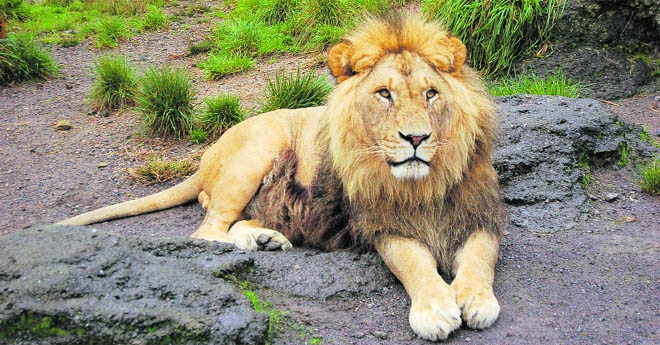
The Asiatic Lion once had a natural habitat in India. Today its population is confined to Gir, Gujarat. The symbol of our national pride needs consistent efforts to preserve it. Thinkstock
Posted at: Jan 17 2016 12:36AMBaljit Singh, Lt General (Retd)
Thanks to Lord Curzon’s refusal to hunt more lions in the jungles of Junagadh that the royal species survived. In 2013, the apex court allowed translocation of the lion, but efforts to do that have met with some strange resistance. To be able to survive in its natural habitat, the lion needs care and fresh areas to breed. We are duty-bound to help the lionDan Ash, director of US Fish and Wildlife Service, has reminded us: “The lion is one of the planet's most beloved species and an irreplaceable part of our shared global heritage…” and in the next breath, motivate us in India that “If we want to ensure that healthy Lion populations continue to roam…the forests of India, it is up to all of us…to take action” (The Tribune, December 23, 2015). In the geological timeline when Africa was connected with Asia by a “land bridge”, the African Lion had arrived in Asia. Over time the bridge between the two continents eroded. Several factors impacted the biology and morphology of the original but isolated émigré lion population that gradually evolved to emerge as the Asiatic Lion.
Land of Big Cats
It is also another evolutionary truth that once the whole matrix of the
“Living Planet” took firm roots, we on the Indian sub-continent had
inherited a fairly substantial share of the world's diverse faunal
riches. And on the first stock-taking of our inventory, we emerged as
the only country to have had the gift of all the “Four Big Cats” — the
lion, tiger, leopard and the cheetah.
The Asiatic Lion, as the name implies, had a stable population in
today's Turkey, Israel, Syria, Jordan, Saudi Arabia, Iraq, Iran and
India. In northwest India it was such a common occurrence that in the
Jahangirnama the Mughal Emperor states that in a span of 39 years, he
alone accounted for 86 lions, mostly from an area which approximates to
the Panipat-Mathura tract of today. And just as the Mughal empire
extended steadily eastward, so was lion hunting pursued with vigor
through the length and breadth of the Gangetic plain, right up to
Jharkhand and Orissa.
On verge of extinction
Once the British ousted the Mughals, they too showed scant restraint in
pursuit of the lion (even though they had evolved and put into practice
in the UK a code of ethics for “Field Sport” which stipulated controlled
hunting, only). With the availability of more lethal weapons, the
Asiatic Lion in India was almost wiped out as a species by 1900 AD but
for one pride of twenty five animals (some accounts place this figure at
twelve) confined to the Gir Forests of Junagadh, in Gujarat. And by
this time elsewhere in Asia, the species had already been shot to
extinction.
Around the same time, the beleaguered Asiatic Lion in the Gir forest had
something of a solace: Lord Curzon arrived in India. It was a common
practice then for the princes and maharajas to host the viceroy over the
Christmas weekend. In 1902, the Nawab of Junagadh invited Curzon to his
fiefdom for a lion hunt. It is to the credit of Curzon that not only
did he decline the invitation to hunt but instead inveigled with the
Nawab to prohibit lion hunting in totality and save the species from
extinction!
Help arrives
That today their numbers have increased to around 500 is a tribute to
the collective vision of Lord Curzon, Jawaharlal Nehru and the Nawabs of
Jungadh. Much in the spirit of Curzon, Prime Minister Nehru too
provided patronage and political will by personally guiding the Lion
revival National Action Plan which created conditions for the lion to
survive. So, we may now proudly call it the Indian Lion.
On April 16, 2013, wildlife enthusiasts had woken to the cheery news
that the Supreme Court allowed translocation of Asiatic Lions from
Gujarat to Madhya Pradesh saying the species needed a second home. It
gave the wildlife authorities six months to complete the process. A
factor of animal biology perhaps not known to most Indians is that the
entire surviving population of approximate 500 Asiatic Lions in Gir
today has sprung from one common blood-line of 20-odd animals, in 1903.
Implicit in this truth is the potential hazard that they can be wiped
out altogether, in one single epidemic.
So preparations were set afoot back in 1995 to create for the Asiatic
Lion a viable “second home” in Madhaya Pradesh (stocked with adequate
prey-base) at Palanur Kuno, an erstwhile stronghold of the lion till the
1860s. But the effort was scuttled by a fiat of Narindera Modi, the
then Chief Minister of Gujarat, on the argument that (a) since the Union
Government had shown a poor track record in saving the tiger, there is
little hope that they will do better with the lion, and (b) the “second
home” would rob Gujarat of much of its wildlife tourism revenue.
National symbol
We do not know why Emperor Ashoka had installed the Lion atop the
pillars bearing his edicts, hundreds o years back. Over time, the
stylized Lion of Ashoka's pillar, also became the symbol of India in
1952. Thus it has become a tacit article of faith with us that the
Asiatic Lion shall have a permanent home in India for all times to
come.
Thank you, Dan Ash, for providing us a noble cause in 2016.http://www.tribuneindia.com/news/sunday-special/people/let-asiatic-lion-roar-to-its-glory/184423.html
No comments:
Post a Comment